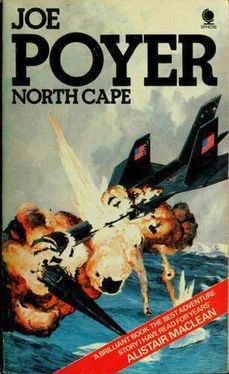“This map shows the flight path of one of our three specially equipped reconnaissance aircraft. The aircraft is capable of speeds in excess of Mach 5 and flight times of…” For a long time Folsom listened to the dry matter-of-fact voice explaining one of the nation’s most closely guarded secrets. After the first few minutes he recovered quickly from the astonishment accompanying the discovery of the exact depth and extent of the surveillance missions that the United States had conducted over the past two years and the role he, or the RFK to be exact, had played. The deeper Larkin went into the explanation/briefing, the more he understood the almost fanatical secrecy that surrounded the project. Not counting the employees at Lockheed and the Air Force crew at GilIon Advanced Test Site, who never were allowed to know the full story, Larkin told him that there were less than fifty people in the United States who knew about the A-17. Fifty people and possibly the entire Soviet military establishment, Folsom thought ironically. Larkin was the only U.S. military official outside the United States territorial boundaries who knew about the A-17, with the exception of a submarine commander in charge of all relay operations for the entire southern hemisphere.
“And that, Pete, is the whole story, or at least as much as I think it is necessary to tell you at this point.” The old man looked piercingly at him. Folsom met his eyes unwaveringly.
“What are your orders then, sir?”
Larkin rubbed the back of his head and walked over to stand and stare out the porthole. His voice, when he spoke, was low, barely carrying across the ten feet that separated them, hinting all the actual loneliness of command that only the captain of a ship, or perhaps the commander of a Strategic Air Command bomber, could feel. The loneliness in knowing that you had no one to *horn you could turn to for advice. “I wish I knew…”
He let his voice trail off.
But with the next breath he swung quickly around from the porthole and said firmly, “For now, we have no choice but to continue to the turn-around point and rendezvous tonight on-station.” He walked briskly back to the desk and handed Folsom another flimsy.
“This is the last message we received after I made the status report an hour ago. It says, quite simply, “Imperative maintain station — Soviets on.”
“Why couldn’t we continue to the lee side of the Cape and wait for him there. One hundred and fifty miles shouldn’t make that much difference to the pilot,” Folsom continued.
“But it does. We have no way Of contacting the aircraft. The pilot must initiate all such contacts with us. Secondly, the radio transmitter that he uses is a VHF-FM set with a range of less than twenty miles, to reduce the chance that hostile ships or aircraft might pick up the transmission. If we aren’t where we said we will be, then he is done. He can’t contact us and we can’t give him his next set of orders. And that set of orders has his next fueling coordinates. Everything possible has been done to lessen the chance of his being discovered by electronic snooping.”
Folsom nodded. “So if we aren’t there, he’s as good as dead.” He paused and massaged his weary eyes. They felt as if large boulders of jagged rock were slowly working their way up under the lids. He had been on duty, without sleep, „for nearly twenty-four hours, and his mental faculties were beginning to match the syrupy slowness of his body. “That is one job that I certainly do not want under any circumstances.”
“How would you like the job of having to be in the right place at the right time, everytime,” Larkin asked bleakly. “You’ve got it, Pete.”
The well-defined southern edge of the Turfan Depression cut a sable horizon line through the pale gold of the Gobi and the dust-laden sky. To his right, the blue expanse of Bagrach Kol gleamed in the late morning sunlight. The Bagrach Kol had the singular distinction of being the largest and one of two free bodies of water in all the Gobi, and it is salty beyond belief. The other was the almost dry and equally salt-laden Lop Nor Basin. For some minutes now the eastern reaches of the Tien Shan had been in view, and from fifteen thousand feet Teleman could easily make out the dark smudge farther down on the southern horizon that was the Kun Lun range.
He flew steadily due south, leaving the alkaline lake and the pebble desert of the Depression behind. When the Tien Shan were well past his starboard wing, Teleman began the long turn east that would take him down the valleys between the two ranges to cross the Soviet border well south, or so he hoped, of the visual tracking net the Soviets had so hastily thrown up.
Beneath, the land began to rise as the flanks of either mountain chain spread out to form a comfortable supporting base. The ground flowing beneath resembled nothing as much as a flat plate, broken here and there with upthrust rock formations, the edges folding up on themselves and sprinkled with a black pepper of stunted scrub bushes reminiscent of mesquite. As always, he was amazed that deserts look so much alike. Looking at the scene sliding past, he would not have been able to distinguish between the Gobi and stretches of Nevada and New Mexico desert.
The Lop Nor was beginning to appear off his starboard wing as he looped back up from the far end of the turn. This last was a maneuver designed to shake any possible last vestiges of Soviet observation. He hoped that the long swing south would be interpreted as an attempt to fly out over the Himalayas to the Bay of Bengal and the Indian Ocean beyond. It was too bad he could not, he thought regretfully. It would certainly be one hell of a lot easier than the long way around that was still to come: As Teleman drew abreast of the second salt lake, the Tarim River, flowing down out of the peaks of Karakorum in. the western Himalayas to Lop Nor, appeared, a thin crooked line of a river swollen now with the first evidence of the spring thaw. As he crossed the Lop Nor he passed into Chinese Eastern Turkestan.
The countryside below appeared considerably colder between the ranges. The snow line reached almost to the floor of the new desert that was beginning to appear ahead, the Taklamakan. Pobeda Peak, rising in an almost sheer vertical from the banks of the Tarim on its southern face, reared up, higher by nearly ten thousand feet than the fourteen thousand feet at which he Was now flying. It occurred to him that this was the first time he had ever flown below a land feature and for some reason it made him uneasy. Possibly, Teleman considered, it was brought on because it put both himself and the A17 into perspective — a perspective that he lost at the two hundred thousand feet that lent him a minor godhead in which he was unconcerned with human fumblings toward power and gain, and made him content with observation and obscured the need for involvement. For long minutes he flew past the shining expanse of the 24,400-foot peak, gleaming along its crest as the sun inched light over its ridges.
For the next forty minutes he followed the Tarim southwest across the Taklamakan until it struggled up through a wicked series of foothills into the Karakormn. From here, relatively safe and comfortable in the heated/air-conditioned cabin of the silent aircraft, gazing at the twisted rills and cols of the mountains, he could feel the excitement that he knew men like Sir Edmund Hillary and Barry Bishop must have experienced when they stood at the foot of a peak such as Kanchenjunga, or Godwin Austen, or Mount Everest, preparatory to beginning the ascent to the “roof of the world,” a term the Sherpas had given the Himalayas, stretching a thousand miles from the Hindu Kush in the west to the Nan Shan in the east. But at the same time, he could only shake his head and wonder why a man would risk his life in the loneliest arena of the world to climb peaks that had been shrouded in snow and wind since man was little more than a gene spark in some species of reptile.
Читать дальше












